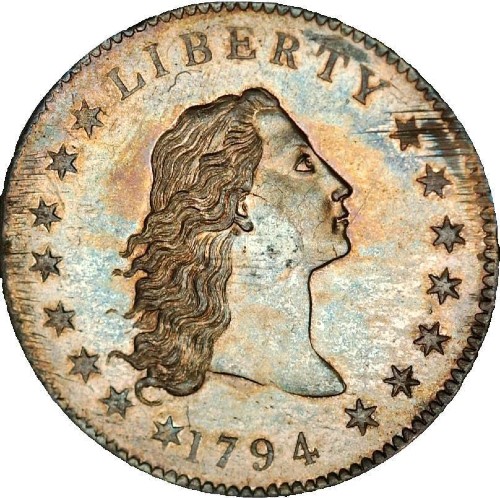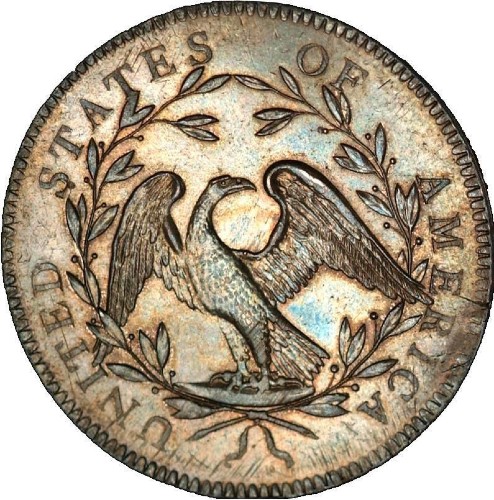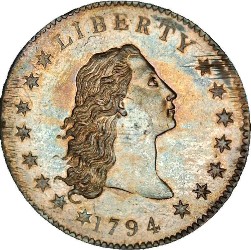
NEW YORK – On occasion, The Hot Bid revisits remarkable antique and vintage collectibles that have sold. Today’s subject is a rare 1794 U.S. silver dollar that sold for $10 million dollars.
What you see: A 1794 “Flowing Hair” silver dollar, described as a “unique superb gem specimen.” Stack’s Bowers auctioned it in January 2013 for just over $10 million and a world auction record for any coin. [Since writing this story, news broke that the coin would go to auction as part of the Bruce Morelan collection in Las Vegas in October 2020.]
The expert: Vicken Yegparian, vice president of numismatics at Stack’s Bowers.
What is the 1794 flowing hair silver dollar, and why is it considered one of the rarest and most valuable American coins? It’s America’s first silver dollar. It’s important for that one simple reason. It predates everything our currency stands for today.
How many 1794 flowing hair silver dollars are known to exist? Estimates range between 135 and 150. Undocumented ones still come out of the woodwork on occasion, but that’s the best guess on how many survive.
And how many 1794 flowing hair silver dollars are believed to have been produced? Records say 1,758 pieces were made.
How were they lost? Were they melted down? Actually, that’s a pretty good survival rate for coins from that era. People recognized what they were back then and saved them.
And I take it it’s called the “flowing hair” silver dollar because the woman shown in profile on the coin has flowing hair? Exactly. If you look at designs for coins from the mid-1790s period, they show the personification of Liberty. They’re all patterned after the Libertas Americana medal in Paris at the Paris Mint. She has the same flowing locks, but with a liberty cap behind her.
Why was the 1794 flowing hair silver dollar created? What need did it meet? It was a necessary coin for the economy, and for the needs of civic coinage. It’s the product of money as a sovereign right. America was starting to flex its muscles, and what does a sovereign state do? Make its own money.
So issuing the 1794 flowing hair silver dollar was just as much about announcing America’s arrival as a country as creating money for its citizens to use? It was a tool for building our reputation? It’s all of that – making our mark in international waters, so to speak. Establishing a mint was one element of nation-building. When they [the U.S. Mint] started, they decided to start with the silver dollar, because the silver dollar was obviously bigger. It’s weightier and more impressive in the hand.
What would $1 in 1794 be worth in 2020 dollars? How much spending power did this coin represent when it was new? It was a very good amount of money. Talking in terms of inflation, it’s worth $25 today.
How much silver is in the 1794 silver dollar? Just over three-quarters of a troy ounce of silver, or .4735 ounces troy of silver, net.
And that’s important because the government promised there’d be a specific minimum amount of silver in its silver dollars, yes? Exactly. The weight of coppers was stipulated within a certain range, but silver was much more stringent. The mint was a fledgling, low-budget operation when it launched. It didn’t have the scientific standards we have today. Back then, if it made an underweight silver dollar, it’d scrap it. If it was over, it’d be filed down to the right weight. This coin had very few adjustment lines, but they’re common on all 1794 silver dollars and 1790s coinage.
How many 1794 silver dollars has Stack’s Bowers handled? Many of them. We’ve been in business since the 1930s. There’s a book documenting all known 1794 silver dollars. At least 75 in that book have passed through our doors – two-thirds of the known pieces traded through Stack’s Bowers or its predecessor.
This example is believed to be the first silver dollar ever struck in the United States. What evidence supports that claim? Before you strike a production run of coins, you test the example in a softer metal. The Smithsonian has a copper version. It’s in the same die state as this piece.
We should pause and explain how coins are physically produced… Stamps that make money are called dies. They’re heavy pieces of iron, with the design at one end. There’s one die on the top, and one on the bottom, with the metal between them. You activate the press and stamp the coin.
The lot notes say the coin shows “prooflike reflectivity in the fields.” What does that mean, and why is that important? Does it support the idea that it could be the first silver dollar ever struck in the United States? The overall surface quality has a prooflike appearance. That describes the reflectivity of the surfaces. It’s mirrorlike. That’s a quality of the die and its ability to impart that surface. That quality diminishes with each strike of the coin. This coin is very well-struck, very well-impressed. All the detail is fine and very visible.
So a coin with prooflike reflectivity is kind of like a print from an early state? That’s a good comparison, but coins are a little bit different. They go from a very reflective finish to a frosty and lustrous surface. Frosty and lustrous is not undesirable, just different.
What other clues support the notion that this 1794 silver dollar might have been the first to be struck? This coin was specially made from specially prepared dies. It didn’t go into a bag with other pieces. They [whoever struck the coin] might have wanted to present special coins to somebody. We don’t know who made it or who saved it, but someone put it aside, and someone saved it for it to have been in such perfect condition.
So we can say this 1794 silver dollar was among the earliest struck, for sure, but we can’t definitively prove it was the first? Today, each die has a serial number and we record the number of strikes. None of that existed in 1794. They had to jury-rig a press to make a coin this big. But we can say beyond a reasonable doubt it was among the first strikes, and among the first prepared. They polished the die to a glossy state so it would create a glass-smooth surface in the metal and impart a glass-smooth surface to it.
Do any other 1794 silver dollars come close to this one? Nothing. Nothing.
The 1794 silver dollar is described as being Specimen-66, as graded by the Professional Coin Grading Service (PCGS). What does that mean, and why is that important? That’s a very high grade for a U.S. coin. Anything remotely near it in silver dollars is huge. The scale is from one to 70. A grade of 67 is super-high. For this coin to be a 66 is a big deal. And it’s a big coin. It’s much easier to hurt a larger coin. If you drop a silver dollar on the ground, you can get a big dent in the edge. To have a 1794 silver dollar that’s so well-preserved and flaw-free relative to its peers … it’s a big deal.
The lot notes also describe it as a “unique superb gem specimen.” Could you break that phrase down and explain it? “Unique” means it’s the only specimen or specially struck 1794 silver dollar that we know of. “Superb” is an old term used in numismatics for over 100 years, from before numeric grading of coins. “Gem” is the best one on the tray. Calling it a “superb gem specimen” is gilding the lily.
What had to happen between 1794 and now for the coin to survive in such good condition? Someone had to forget about it and let it sit in a family collection for 200 years or be really cautious in its handling. It’s a miracle that it’s survived this well. It’s indicative that it was specially made and specially saved.

Why didn’t Stack’s Bowers sell this 1794 silver dollar as a single lot in a stand-alone auction? It was part of a collection, so we kept it as such.
Have you seen this 1794 silver dollar or any other 1794 silver dollars out of their plastic capsules? By the time I saw it, it had been encapsulated for a while. I have held other 1794s, before they were certified. Getting a chance to hold it in its raw state is almost impossible. But even one that’s beat up and well-worn is very cool.
What estimate did Stack’s Bowers put on this 1794 silver dollar? We don’t provide printed estimates for most of our auctions, and we didn’t publish an estimate on the coin. Bidding started at $2.2 million and rose from there.
What was the previous world auction record for any coin prior to the 1794 silver dollar? It was $7.5 million, for a 1933 double eagle sold by Stack’s Bowers and Sotheby’s in 2002.
What was your role in the auction of the 1794 silver dollar? I was on the phone with a client.
Was the winning bidder in the room? A representative of the winner was in the room, doing the actual bidding – Laura Sperber, on behalf of her client, Bruce Morelan. It’s still in his collection today. [Since taking this interview with Yegparian, PGCS announced that Morelan will auction his collection, including the record-setting 1794 silver dollar, in October 2020 in Las Vegas.]
The 1794 silver dollar sold for just over $10 million. Were you surprised? I was super surprised. There were no previous comparables [similar lots offered previously at auction] that would say the coin would bring $10 million that day. The closest was the 1933 gold piece.
When did you know you had a new world auction record? The minute the hammer fell. I think everyone was gobsmacked when the number was presented. We all knew the record for the 1933 double eagle. To get to $10 million – that’s faraway an obvious record. No one thought it would happen. I think the bidders kept their cards close to their chests. I don’t think a new record was a glimmer in anyone’s eye.
This coin was the first to cross the $10 million threshold at auction. Could you talk about what that meant to the world of coin-collecting? It seems that coins are like books, in that sales records go back fairly far. I recall reading that a coin crossed the $1,000 auction threshold in the 19th century … It was huge. I don’t know when the $10,000 sale happened, but it wasn’t until the 1970s that one hit $100,000. It took another 20 years to pass $1 million. Twenty years after that, one hit $10 million. I don’t think we’ll cross $100 million any time soon. The next realistic threshold will be $20 million. Many “greats” can be attributed to this coin. This one could break its own record.
How long do you think this record will stand? I don’t think it will fall tomorrow, but I hope it doesn’t take 30 years. I hope the record will break in the near term.
Why would it be better for this coin or one like it to come to auction relatively soon? Sometimes, you need a coin to trade to get it into peoples’ consciousness. If it goes away for 50 years, people might forget about it or think they aren’t able to own it. This coin last sold in 1984, and it brought $250,000, or thereabouts. In 30 years, it’s gone from $250,000 to $10 million.
To what do you credit the rise in price? Is demand higher? There are more well-heeled collectors in numismatics. Liquidity in the market plays into the desire to own those things. With the stay-at-home orders [the shelter-in-place recommendations due to the COVID-19 pandemic], collectors might have extra time to put into hobbies.
What else could meet or beat it? Is it pretty much this coin or an 1804 silver dollar? Exactly. This coin, or an 1804 silver dollar. That’s where story and value meet. Another coin we talked about [that could do it] is the pattern coin for the $20 gold piece.
What’s a pattern coin? An artist or a sculptor might put out a design for a coin. The iterations don’t always survive in any form, never mind the coin. For 1907 [the year in which Augustus Saint-Gaudens died, after creating but not finalizing designs for an eagle and a double eagle coin] there’s one iteration of an individual head design that was used on the $10 coin [the single eagle]. It definitely hasn’t traded in recent decades at auction. A coin like that would have all the factors that would produce a price above $10 million.
Why will this piece stick in your memory? If it were a common coin from that era, of this quality, it’d be memorable. It’s a special coin in many regards, and it was a crowning moment in my career. It’s just superior.
___
By SHEILA GIBSON STOODLEY
Sheila Gibson Stoodley is a journalist and the author of The Hot Bid, which features intriguing lots coming up at auction.



